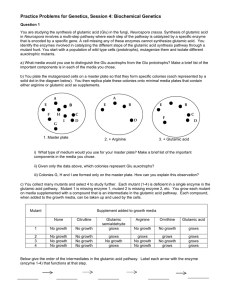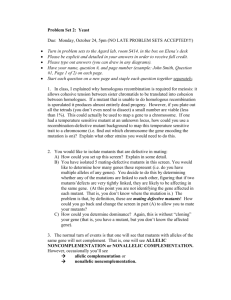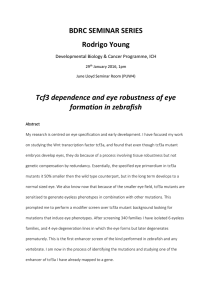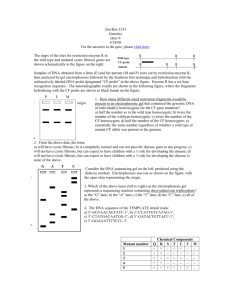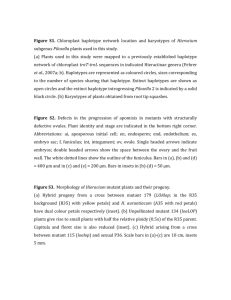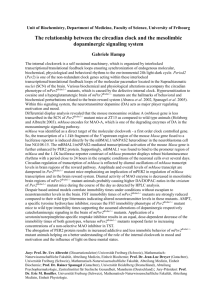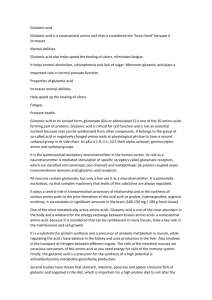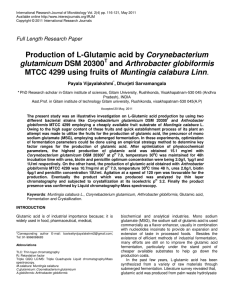Solutions to Practice Problems for Genetics, Session 4: Biochemical Genetics
advertisement
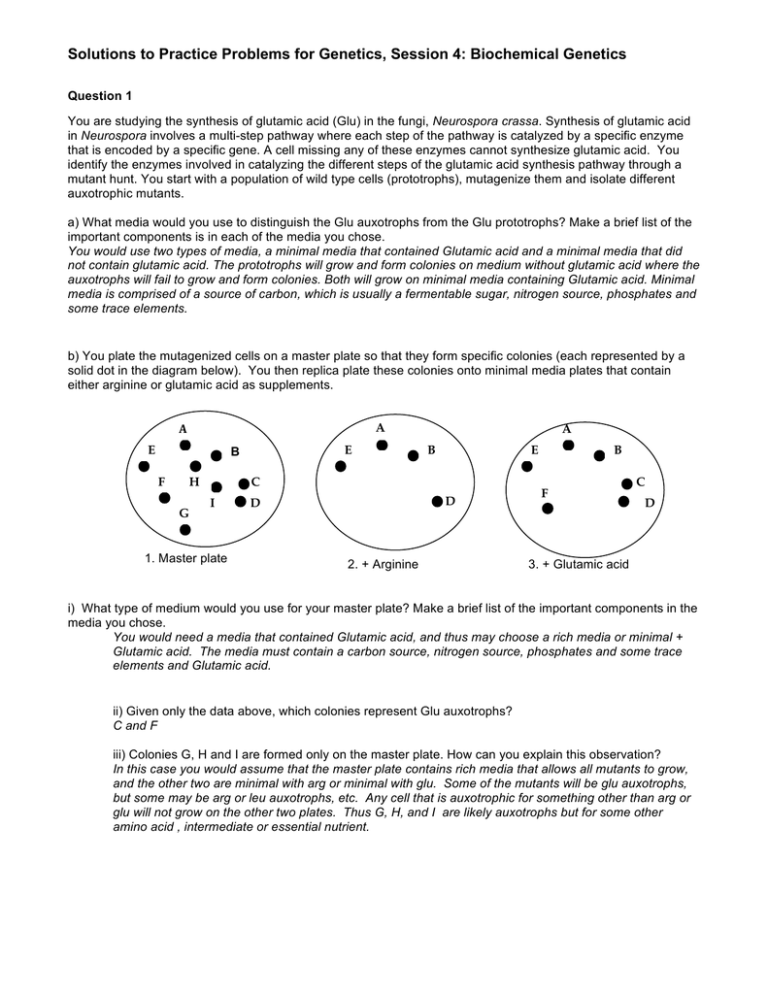
Solutions to Practice Problems for Genetics, Session 4: Biochemical Genetics Question 1 You are studying the synthesis of glutamic acid (Glu) in the fungi, Neurospora crassa. Synthesis of glutamic acid in Neurospora involves a multi-step pathway where each step of the pathway is catalyzed by a specific enzyme that is encoded by a specific gene. A cell missing any of these enzymes cannot synthesize glutamic acid. You identify the enzymes involved in catalyzing the different steps of the glutamic acid synthesis pathway through a mutant hunt. You start with a population of wild type cells (prototrophs), mutagenize them and isolate different auxotrophic mutants. a) What media would you use to distinguish the Glu auxotrophs from the Glu prototrophs? Make a brief list of the important components is in each of the media you chose. You would use two types of media, a minimal media that contained Glutamic acid and a minimal media that did not contain glutamic acid. The prototrophs will grow and form colonies on medium without glutamic acid where the auxotrophs will fail to grow and form colonies. Both will grow on minimal media containing Glutamic acid. Minimal media is comprised of a source of carbon, which is usually a fermentable sugar, nitrogen source, phosphates and some trace elements. b) You plate the mutagenized cells on a master plate so that they form specific colonies (each represented by a solid dot in the diagram below). You then replica plate these colonies onto minimal media plates that contain either arginine or glutamic acid as supplements. A A E E B F H G A B E C I 1. Master plate D D 2. + Arginine B F C D 3. + Glutamic acid i) What type of medium would you use for your master plate? Make a brief list of the important components in the media you chose. You would need a media that contained Glutamic acid, and thus may choose a rich media or minimal + Glutamic acid. The media must contain a carbon source, nitrogen source, phosphates and some trace elements and Glutamic acid. ii) Given only the data above, which colonies represent Glu auxotrophs? C and F iii) Colonies G, H and I are formed only on the master plate. How can you explain this observation? In this case you would assume that the master plate contains rich media that allows all mutants to grow, and the other two are minimal with arg or minimal with glu. Some of the mutants will be glu auxotrophs, but some may be arg or leu auxotrophs, etc. Any cell that is auxotrophic for something other than arg or glu will not grow on the other two plates. Thus G, H, and I are likely auxotrophs but for some other amino acid , intermediate or essential nutrient. Question 1, continued c) You collect many mutants and select 4 to study further. Each mutant (1-4) is deficient in a single enzyme in the glutamic acid pathway. Mutant 1 is missing enzyme 1, mutant 2 is missing enzyme 2, etc. You grow each mutant on media supplemented with a compound that is an intermediate in the glutamic acid pathway. Each compound, when added to the growth media, can be taken up and used by the cells. Mutant Supplement added to growth media None Citrulline Arginine Ornithine Glutamic acid No growth Glutamic semialdehyde grows 1 No growth No growth No growth grows 2 3 4 No growth No growth No growth No growth No growth No growth grows No growth grows grows No growth No growth grows No growth grows grows grows grows Below give the order of the intermediates in the glutamic acid pathway. Label each arrow with the enzyme (enzyme 1-4) that functions at that step. 2 Citrulline 4 Arginine 1 Ornithine 3 Glutamic semialdehyde Glutamic acid d) Explain how the pathway for glutamic acid synthesis outlined above, affects your answer to (b) part (ii) above. Given only the data from the plates, we assumed that colonies A, B, D, and E were not Glu auxotrophs, because they could grow in the absence of glu (i.e., on minimal + arg). However, if the pathway above is correct, then one or more of these colonies could be Glu auxotrophs that had a mutation in enzyme 2, such that can grow when supplemented with arginine. e) Many fungi have both haploid and diploid life cycles. What type of cells would you have used in your original mutagenesis? Explain your answer. Either could be used, but a haploid cell would be preferred. If the mutagenesis is done on haploid cells, then cells that suffer a mutation resulting in a recessive phenotype will also be recognized. Question 2 You do a second mutant hunt to screen for histidine mutants and isolate 15 mutants. You find that the hisphenotype is recessive in mutants 1-14, but dominant in mutant 15. You then organize the mutants based on complementation groups. a) Describe the experiment that you performed and the results that you obtained which allowed you to determine that the his- phenotype is recessive in mutants 1-14, but dominant in mutant 15. Each haploid mutant would be mated with a wild-type haploid cell to create a diploid. If the resulting diploid does not require histidine, then the his- phenotype of the mutant is recessive. However if the resulting diploid needs histidine, then the his- phenotype is dominant. b) Describe how you would determine complementation groups for each of your mutants and explain what it means if two mutant are in the same complementation group as opposed to in different complementation groups. The complementation groups of various his- mutants can be determined through the complementation assay in which the haploids are mated together to form diploids. If the resulting diploid is wild-type, then the assumption is that the mutations in each cell are in a different gene, and the mutants are said to complement each other. However, if each mutant has a mutation in the same gene, the resulting diploid will be his-. In this case, the mutant fail to complement. Question 2, continued c) The following is the result of a complementation assay. Here (-) represent no growth on minimal media and (+) represent growth on minimal media. Based on the information provided, arrange the mutants into complementation groups. A1 A2 A3 A4 A5 A6 A7 A8 A9 A10 A1 - A2 + - A3 + - A4 + + - A5 + + - The following are the complementation groups A1, A3 and A5 (group 1) A2, A4 and A6 (Group 2) A7 and A8 (Group 3) A9 and A10 (group 4) A6 + + + - A7 + + + + + + - A8 + + + + + + - A9 + + + + + + + + - A10 + + + + + + + + - MIT OpenCourseWare http://ocw.mit.edu 7.01SC Fundamentals of Biology Fall 2011 For information about citing these materials or our Terms of Use, visit: http://ocw.mit.edu/terms.
